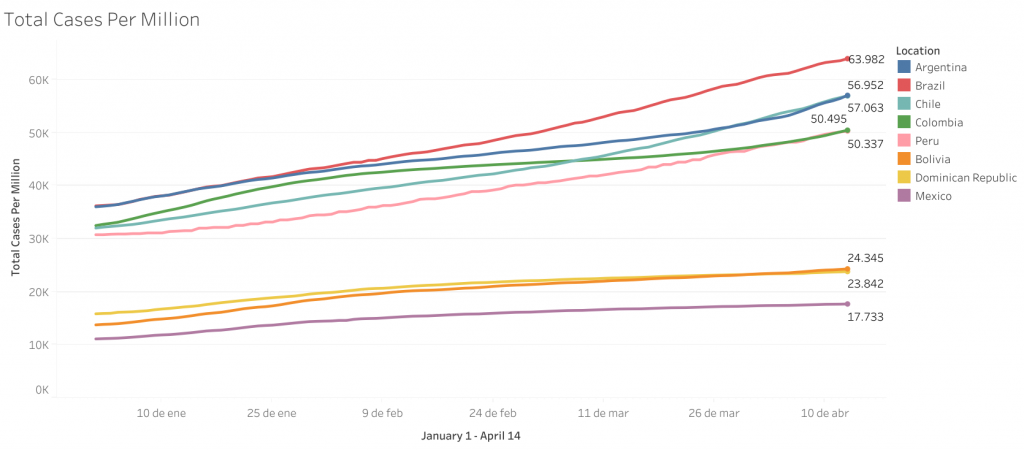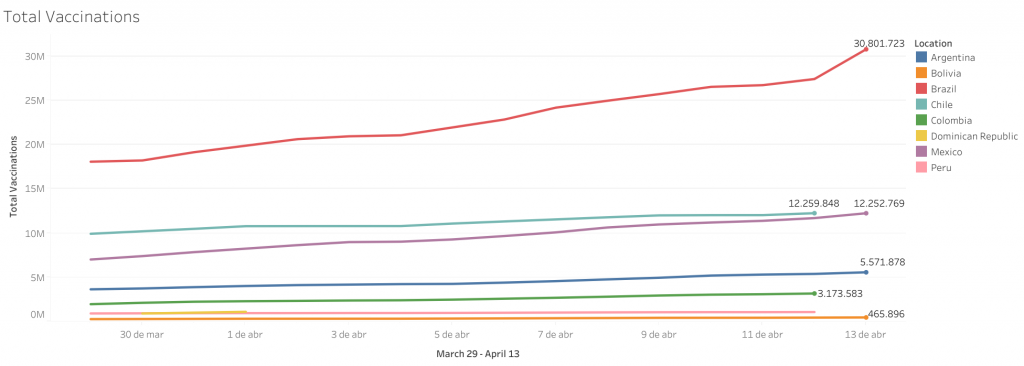What You Should Know
- Unemployment: Since the COVID-19 pandemic began, one in six young adults (ages eighteen to twenty-nine) in Latin America have stopped working.
- Vaccines: The COVAX mechanism has delivered over 38 million doses of COVID-19 worldwide, of which only 3 million have been delivered to twenty-eight countries in the Americas. PAHO Director, Dr. Carissa F. Etienne, is calling for immunization in the Americas to become a global priority.
- Post-COVID-19 Outlook: Amid mass vaccine campaigns across Latin America and the Caribbean, join the Adrienne Arsht Latin America Center and the Scowcroft Center for Strategy and Security next Thursday, April 22, for a conversation on what might be the region’s post-COVID-19 outlook.
- 37,000: The region reported more than 37,000 deaths last week. Half of the total global deaths reported for the week occurred in the Americas. Here are this week’s figures.
Health + Innovation
- Blood Clots, Part I: After its initial finding last month that there was no convincing link between the Oxford/AstraZeneca vaccine and rare blood clots, the European Medicines Agency (EMA) has now announced that blood clots should be listed as a “very rare side effect” of the vaccine. Yet, the WHO said that a causal relationship, while plausible, is not confirmed. Both organizations stressed that the benefits of the vaccine outweigh its risks.
- Blood Clots, Part II: The US has paused the use of the Johnson & Johnson vaccine after blood clots emerged in six recipients. To date, almost 7 million people in the US have received the vaccine.
- Jamaica: Over 47,000 people have received the AstraZeneca/Oxford vaccine. The health ministry has assured that there have been no local reports of blood clots associated with the vaccine to date.
- Brazil: With at least 92 COVID-19 variants detected, Brazil’s cases and deaths continue to surge, driving a third wave across South America.
- Trinidad and Tobago: 40,000 AstraZeneca vaccine doses – a donation by the Government of India – arrived on April 13.
- Mexico: The country’s domestically produced vaccine, “Patria,” began clinical trials earlier this month. The National Council of Science and Technology (Conacyt) says the vaccine could be approved as early as November or December.
- Panama: On April 9, China’s Sinovac vaccine was approved for emergency use.
Economies in Focus
Multilateral Analysis
- Fitch Ratings improved its regional outlook, increasing 2021 GDP growth expectations to 4.6 percent, citing China’s economic recovery, the US stimulus bill, and an increase in the price of primary goods.
- PAHO Director Dr. Carissa Etienne explained that the recent increase in cases in Brazil, Colombia, Venezuela, Peru, and Bolivia was alarming but not surprising. She attributed the increase in cases to relaxed restrictions saying, “the crowds are back, and people are gathering inside and taking public transport, often without masks.”
Economic Impact
- The IMF’s new figures show a 7 percent GDP contraction for Latin America and the Caribbean in 2020. The Fund expects the region’s economy to expand 4.6 percent in 2021.
- The Dominican Republic’s Central Bank reported that GDP per capita fell 11.6 percent last year, the largest economic crisis since the country’s 2003 banking crisis.
Quarantines + Travel Restrictions
Quarantines + reopenings
- Argentine authorities announced new restrictions including a curfew from 12:00 a.m. until 6:00 a.m. daily, and restricted hours for restaurants and bars. The measures, which will remain in place until April 30, affect 25 million people, more than half of the population.
- Colombian President Iván Duque announced a four-day quarantine in Bogotá and Medellín beginning at midnight on April 15. Citizens will only be allowed to leave their houses for one hour of exercise and access essential services based on the last digit of their identification number.
- Mexican authorities updated the four-colored traffic system regulating the states’ COVID-19 restrictions. Nineteen states were classified as orange (high risk), five were classified as yellow (medium risk) and eight were classified as green (low risk).
- Bolivian President Luis Arce extended countrywide COVID-19 containment measures allowing subregional governments to regulate the hours of malls, social events, sports facilities, bars, and restaurants until April 30.
- Uruguay extended restrictions to slow the spread of COVID-19 until April 30 including the closure of all non-essential public offices, gyms, duty-free shops, and the suspension of celebrations and social events.
- Paraguay extended restrictions on circulation until April 19 amid a surge in cases. The measures, originally put in place on April 10, include a nightly curfew from 12:00 a.m. until 5:00 a.m.
Border and travel restrictions
- After originally extending border closures with Brazil in three provinces until April 16, Bolivian authorities reopened the border in the city of Cobija, following protests. The rest of the measures remain in place.
- On April 12, France suspended all flights to and from Brazil until further notice.
- Beginning April 19, Panama will require all travelers to present a negative COVID-19 test to enter the country, although travelers from South America will only be required to quarantine for three days instead of five.
- In Brazil, Rio de Janeiro authorities partially eased COVID-19 restrictions allowing restaurants, shops, and bars to reopen with reduced operating hours, after fourteen days of stricter measures.
In Focus: LAC’s Post COVID Outlook
- Despite economies bouncing back from COVID-19’s initial economic devastation, the IMF predicts that regional output will not return to pre-pandemic levels until 2023, later than the rest of the world.
- While the full social effects of the pandemic have yet to be seen, the WEF’s 2021 Global Gender Gap Report estimates that COVID-19 has set women back 36 years and the World Bank predicts that gender gaps in labor force participation gap could lead to a 14 percent decline in GDP per capita over the next three decades.
- Research initiated by the Inter-American Development Bank identifies three key drivers of change that are most relevant for determining the region’s post-COVID future: a) public health outcomes; b) societal agency; and 3) LAC in the global landscape. On April 22, we will look at how these factors will impact Latin America and the Caribbean’s post-COVID-19 scenarios.
By the numbers
- Cases by country: Brazil (13,960,574) #3 worldwide, Argentina (2,579,000) #12 worldwide, Colombia (2,569,314) #13 worldwide, Mexico (2,286,133) #14 worldwide, Chile (1,094,267) #22 worldwide, Panama (359,121) #46 worldwide, Ecuador (347,589) #47 worldwide, Bolivia (284,183) #53 worldwide, Dominican Republic (258,637) #58 worldwide, Paraguay (240,141) #62 worldwide, Source: worldometers.info
- Prevalence rate (total cases per million people: Aruba (10,122) #9, Panama (82,222) #16 worldwide, Curaçao (69,433) #30 worldwide, Brazil (63,636) #41 worldwide, Chile (56,861) #51 worldwide, Argentina (56,657), Colombia (50,078) #57 worldwide, Peru (49,796) #58 worldwide, Costa Rica (43,922) #65 worldwide, Saint Martin (43,211) #68 worldwide, Source: worldometers.info
- Deaths per capita (deaths per million people): Brazil (1,678) #15 worldwide, Peru (1,665) #16 worldwide, Mexico (1,618) #19 worldwide, Panama (1,413) #25 worldwide, Colombia (1,296) #30 worldwide, Argentina (1,278) #32 worldwide, Chile (1,276) #33 worldwide, Bolivia (1,059) #38 worldwide, Ecuador (972) #42 worldwide, Aruba (859) #49 worldwide, Source: worldometers.info
Quick take



